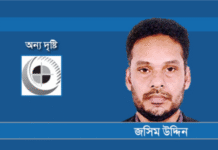Huntington’s ‘The Clash of Civilizations’ as theory suffers uncomplicatedness in comprehension, and can generate allurement en mass. For its vertical unpretentiousness, it could be a useful mannequin for foreign policy strategists. It could be misinterpreted which in turn could make world a lesser safe place endangering the human species.
Bangladesh was born in the midst of cold war rivalry, through struggle against colonial rule by freedom loving people. At birth Bangladesh vowed to uphold secularist principle in its constitution but after 40 years it has now lesser people in its minority groups, and has Islam as its State Religion smuggled into its Constitution. Approximately, 2-4% of the voting public regularly subscribes its extreme right wing politics. Reports of violent clashes in mediaeval moulds are regular where religious minorities have been attacked, their properties and places of worships violated by organised extremists, sans provocation or under flimsy pretext. Secularist media claims majority of these can be traced to greed and voracities to frighten people out of their properties in the ever increasingly populated country.
The above development is a strong reason to scrutinise if and any link with Huntington’s contention that civilization clashes are inexorable within cleft (semi) countries, and these incidents are symptomatic of it, juxtaposing the same on Amartya Sen’s ‘Identity & Violence.
Briefly, Huntington proposes that people’s cultural and religious identities will be the primary source of conflict in the post-cold war world; and will be confounded between Muslims and non-Muslims.
He argues that civilizations forms highest rank of cultural identity. Due to increased proximity and modernisation, people have become civilization conscious, isolated and religion sensitive; and global politics will be dominated by these civilisation oriented conflicts.
Huntington’s civilization categories are Western (see map); Latin American; Orthodox world of the former Soviet Union; Mixed bag of Buddhist, Chinese, Hindu, and Japonica civilizations; Islam; the African world except Ethiopia and Haiti (who are no-civilization lone countries); and Israel.
Cleft countries: Countries that contain large groups of people identifying with separate civilizations, for examples India (with Hindu majority and large Muslim minority), and Ukraine (with Catholic-dominated western section and its Orthodox-dominated East).
Critics have pointed to superciliousness in the civilisation classification. It is veiled and aimed to serve West corporate interest, in the uninterrupted oil supply from Muslim world of Greater Middle East and in the sustenance of their arms industry. Incidentally, these countries rely heavily for their security on the West.

Photo: bdnews24.com
Another criticism lies in the sub classification of Cleft countries—the fertile grounds for ethnic clashes that form the bulk arm sales customers—that includes Japan and Russia who may change side as it fits as seen during Chechnya and Iran crises.
If Huntington’s hypothesis is a ‘Doomsayer’s guide to war and conflict; and how not to survive it’ then Amarty Sen’s ‘Identity & Violence’, may just work as the vaccination toward ideological contagion.
As a young boy, Sen personally witnessed sectarian killing of a Muslim day labourer in Hindu majority section of the city during a Hindu-Muslim riot. The stab-wounded man died on the way to hospital in Sen’s car. This profoundly affected him and made him wonder why a man’s identity is important.
In his book Sen dissects singular identity concept and thoughts, which form the basis of multi-polar world which put the people of different regions in supposedly different parts of the equivalence who are morally or otherwise inferior locus than that of the western part.
He is less evocative that civilizations will conflict because of a cultivated failure to appreciate the true diversity of identities that infuse them. Sen describes the dangers of this undermining of human identity.
Sense of Identity or a Singular Identity can be source of pride and inspiration, strengthening sharing people’s bond. During Bangladesh’s Liberation War this became clear as such a bond united pro-liberation minded people upholding the image of their country. But when an identity is imposed upon someone, they can be deployed to act in such a way that can trigger violence.
There is also a problem where one cannot escape from being seen as one or the other. For example, if a Muslim born Bangladeshi is treated as a Muslim only (say, by Christian fanatic), this assumes that he will uphold all that comes with a Muslim fundamentalism; this is tantamount to externally infusing him with fundamentalist sentimentalism.
Identities are robustly plural, and never mutually obliterating. A person does have a choice, in any context, of any one or multiple identities. A Bangladeshi Muslim freedom fighter could be liberal, westernised, and secular by choice. But singular identity concept could render him to be a Muslim only, an imposed identity not reflecting his true character. He then can be manipulated, with particular assumptions assigned to him, to make him act in a desired way, and subject him to religious prejudices.
Sen asserts that people do not view human beings in inter civilisation relation. He dismisses the prescription of ‘dialogue among civilisations’ for it decimates the century old diversified and rich practices of cultural and shared human interest exchanges. It is a distortion to assume that a Bangladeshi cannot also be liberal, westernised, free thinker and a Muslim, all at the same time.
 How far can one escape from the reasoning and ethics available to him through his community and culture? Sen points to the ingenuity of mind and its ability to doubt and question, which is uniquely human.
How far can one escape from the reasoning and ethics available to him through his community and culture? Sen points to the ingenuity of mind and its ability to doubt and question, which is uniquely human.
Even if we accept the civilisation classification is clash then inevitable? How does one explain inter-civilisation clashes such as that between Tutsis and Hutus?
Civilisation approach suffers from a sense of sumptuousness which is a sophisticated version of a crude popular belief; singularity is an illusion. People are different in many diverse ways, but are same all over.
Classification of India as Hindu civilisation is flawed, it being the second largest Muslim country in the world with shared history with Shiks, Muslims, Jains and Buddhists. This simplistic notion remains a threat of renewed promotion of sectarian conception that’s often referred to by Hinduvta movement.
Even if we accept India is a religiously divided civilisation, Pakistan’s creation proved to be illusory, when its secular eastern part seceded from its other half. The perceived enemies during the India division then went to fight hand in hand against the friends that were friend only two decades ago proving that the origin of Hindu-Muslim conflict was the product of divide and rule policy of the East India Company.
Sen refutes Huntington claim that, ‘West was west long before it was modern’. Pointing that the tradition of individual rights and liberties were unique among civilised societies all over, only the West is champion of political liberty is a myth. Plato and Aquinas were no less authoritarian than Confucius; and Ashoka and Akbar were liberal rulers in comparison with their western counterparts of their time.
Democracy is also a shared development of the whole world, consisting of voting system and public reasoning, practiced in Iran, India and in Muslim kingdoms. Greek system failed in making an impact on European countries. Same can be said about the so-called Western science, the theoretical roots of its many aspects can be traced in places other than the West.
When the civilization theory ignores the divergence of most civilisations, religion centred view is no plausible alternative. Muslims differ amongst themselves in their beliefs, taste and even of their religiosity but they are not non-compliant with Muslim identity. Arabs cultured Europe during its Dark Age, which re-entered Europe at the advent of its Renaissance.
Global terrorism has created overall confusion giving the impression that being a Muslim or Bangladeshi or both means being confrontational and militant. This, along with militant recruitment in the West, and externally instigated and premeditated skirmishes in Bangladesh undermined the effort of Secular Muslim activist leaders to address civil and social problems. They are end-results of consequences of the war and atrocities in Iraq and Afghanistan, internal politics of Bangladesh and the forces that want to see or show the country as unstable.
I personally hold, that there is an orchestrated international or regional campaign to portray Bangladesh as a Muslim country where fundamentalist sentiment have been engulfing minds of increasing number of people. Its apparatuses and institutions are failing to the requirement of a modern state, while its population remains blissfully indifferent (Bangladesh’s 11th position in the happiness index) to all these, taking these lapses and failures as the state of the things. The combination of these statistics and incidents are suggestive in that Bangladeshis are a natural unruly people and not yet ready for self-government!
If hating is an art, singular identity concept is a good platform to launch it. The fragmentary logic is – yes the identity is true but it is exclusive and is of preponderance importance of other affiliation and it demands redefinition into a belligerent form.
Source: bdnews24










